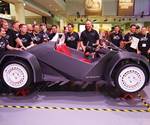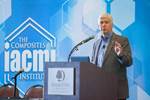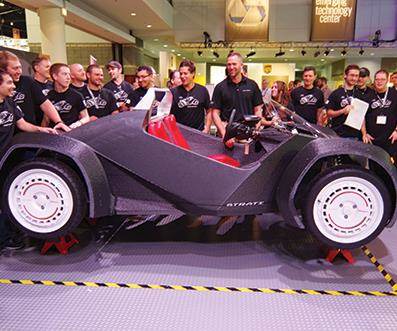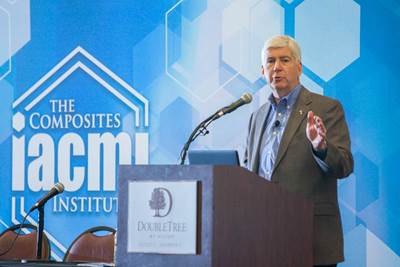IACMI – One insider’s perspective
A CW columnist, a composites industry consultant and the chief commercialization officer for the Institute for Advanced Composites Manufacturing Innovation (Knoxville, TN, US), Dale Brosius asks, “What if we took a ‘big hat’ approach to reach faster, more cost-effective solutions?”
I’ve been lucky to have this platform from which to opine about the state of the composites industry, a privilege I was offered while at the JEC show in 2013. I was even luckier, when, in January 2015, I was formally offered the position of chief commercialization officer for the newly announced Institute for Advanced Composites Manufacturing Innovation (IACMI, Knoxville, TN, US). Under-pinned by funding from the US Department of Energy (DoE), the Institute represents the largest investment by the US government in advanced composites outside the aerospace and defense industries. In my opinion, it offers a fantastic chance to ensure the US composites industry remains on par with the rest of the world, takes the lead in certain areas and commercializes world-leading technology in industrial applications.
I also participated in the formulation of IACMI’s strategy and its winning proposal to DoE, over the course of 2014. I’ve spent my entire career in industry, working for large and small companies in various fields of composites. Although I knew a fair number of individuals who do the work on university research teams and in the national laboratories through professional societies and conferences, I had only infrequent, modest interaction with their employers. And it was those universities and national labs that comprised the majority on the IACMI proposal team.
What has been most eye-opening for me is the incredible number of truly brilliant people and the quantity of accessible assets that exist in the IACMI ecosystem, of which I, an involved industry veteran, was not fully aware. The universities and national labs have accrued significant leading-edge experience in many aspects of composite materials and structures and have amassed analytical equipment (some of it very expensive and specialized) and manufacturing processes at various scales. And this will expand as IACMI launches its forthcoming scale-up facility in Detroit, where full-sized automotive structures will be fabricated, and at the modeling-and-simulation hub at Purdue University in Indiana, which will host much of the world’s leading composites design and process simulation software. I believe accessing these capabilities is important to businesses of any size, but especially to small and medium enterprises (SMEs), for which making such investments in capital and talent are often cost-prohibitive and a significant barrier to developing innovative solutions.
During my time with Quickstep Composites (Dayton OH, US), we conducted some high-speed crush testing at Oak Ridge National Laboratory (Oak Ridge, TN, US) and some mechanical testing at University of Dayton Research Institute (UDRI, Dayton, OH, US), but clearly overlooked some other opportunities due to our small size. An important part of IACMI’s mission will be to help SMEs tap into this talent and equipment at a fraction of the full cost, partly due to matching support from DoE and state investors, and to do so flexibly and responsibly.
Such capability is not limited to IACMI. Excellent support is available to industry at universities, each with a strong composites heritage, on the US East and West Coasts. In fact, the same is true via institutes and universities across the globe. I’ve been fortunate to have met with the leadership of many of them in Canada, the UK, France, Germany, Australia and elsewhere. A number of IACMI member companies are multinationals that also invest in other institutes and sometimes have to decide which projects to place where.
That begs a big question: Do these institutes need to “go it alone”? Why can’t they leverage their investments to jointly tackle some of the biggest challenges, such as embodied energy, confidence in predictive modeling, recycling and high-speed manufacture of complex shapes from continuous fiber materials? The problems we face here are not trivial impediments to expanding the market for advanced composites and, given the global nature of competition, our solutions would be adopted around the world. I believe there is a need to establish lines of communication, and even explore potential collaboration, between IACMI and the world’s other composites institutes.
Yes, it’s problematic: Most institutes that work on composites have some level of regional or national public funding justified on the premise that such investment in technology development creates needed jobs and industrial capital investment. The natural tendency, then, will be to resist open collaboration in hope of developing first-mover advantage, typically manifested in higher exports or reduced imports of goods. But international collaboration has the potential to reach solutions faster and in a more cost-effective manner, which benefits everyone’s government investors and industrial partners simultaneously. It’s a “big hat” mentality. It’s also, no doubt, a challenge to execute, especially as we consider how to share the costs, effort and resulting intellectual property.
Can we make it work? We won’t know unless we give it a go.
Related Content
Infinite Composites: Type V tanks for space, hydrogen, automotive and more
After a decade of proving its linerless, weight-saving composite tanks with NASA and more than 30 aerospace companies, this CryoSphere pioneer is scaling for growth in commercial space and sustainable transportation on Earth.
Read MoreThe potential for thermoplastic composite nacelles
Collins Aerospace draws on global team, decades of experience to demonstrate large, curved AFP and welded structures for the next generation of aircraft.
Read MoreThe lessons behind OceanGate
Carbon fiber composites faced much criticism in the wake of the OceanGate submersible accident. CW’s publisher Jeff Sloan explains that it’s not that simple.
Read MoreRecycling end-of-life composite parts: New methods, markets
From infrastructure solutions to consumer products, Polish recycler Anmet and Netherlands-based researchers are developing new methods for repurposing wind turbine blades and other composite parts.
Read MoreRead Next
CW Ideas in Action
Ideas are just ideas until someone does the hard work of putting them into action and seeing results. CW's editors, therefore, inaugurate an annual review of Ideas in Action, celebrating a handful of hot concepts that could make those who conceived them "household names."
Read MoreIACMI starting to walk the talk
The Institute for Advanced Composites Manufacturing Innovation (IACMI) is six months into its five-year life and is showing signs of collaborative-based innovation.
Read MoreAll-recycled, needle-punched nonwoven CFRP slashes carbon footprint of Formula 2 seat
Dallara and Tenowo collaborate to produce a race-ready Formula 2 seat using recycled carbon fiber, reducing CO2 emissions by 97.5% compared to virgin materials.
Read More





















